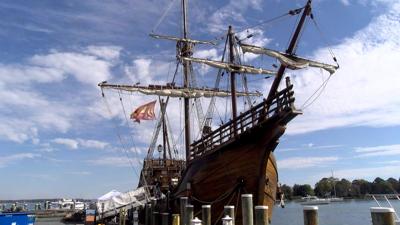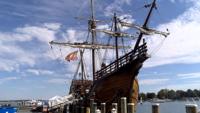ST. MICHAELS, Md. - The Spanish flag is flying high over St. Michaels for the next week.
The flag is flying off the stern of the Nao Trinidad, currently docked at the Chesapeake Bay Maritime Museum.
Nao Trinidad is an educational ship telling part of the story of Magellan's 1519 around-the-world expedition.
"Our replica was built in 2017 and 2018 in Huelva, Spain, which is where the original ships would have been built, it's been a shipbuilding area for 500 years," said crewmember Jaye Lunsford.
The original Nao Trinidad was the flagship of the five-ship Magellan-Elcano Expedition. The ship, however, did not survive the voyage. As a result of damage from storms and insufficient crew, it sank in what is today Indonesia sometime in early 1523.
Today's Nao Trinidad is 93 feet long and 82 feet high, with a displacement of 200 tons. It recreates many of the conditions that sailors would have lived in on that unprecedented and dangerous voyage.
The ship, which does have a modern engine and navigation equipment installed, can however be operated using only traditional sail and navigation techniques, which have but the 21st Century crew to the test.
"And you realize the relief they must have felt," said Lunsford. "And maybe this is why the birds chirp in the morning, they say 'hey, I survived another night, it's going to get better from here.' It's really really easy to put yourself in their shoes."
According to Chesapeake Bay Maritime Museum historians, the Chesapeake has more of a connection to Spain than many think.
"The Chesapeake actually was first discovered by Spanish explorers. They never permanently settled here, but there are Hispanic roots in the exploration of the Americas, even the Chesapeake Bay," said Pete Lesher, chief historian at the Chesapeake Bay Maritime Museum.
Nao Trinidad can be visited at the Chesapeake Bay Maritime Museum through November 5. There is a fee of $12 for adults and $5 for children, in addition to museum admission.
Nao Trinidad's next port of call will be Crisfield, Md.



